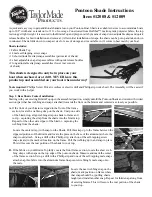
14
© Carlo Gavazzi A/S
es in the VIP area� Usually, this area will have its own segment and we name it ID8� Use the same
procedure as for the Handicap in segment 1� The 3-colour sensor has the option for programming 3
addresses� The Status address must always be in consecutive order starting from A1 to B7, and then
it is optional which addresses shall be used for e�g� LED CH1 and LED CH2� However, the addresses
must be unique�
Segment 5 starts with A1 and end with J3�
Example of a PGS for Multiple Floors
Planning a Parking Guidance System, or PGS, with multiple floors implies the same considerations
when planning one´ floor only� Determine displays, segments, natural car flow in the Parking Guidance
System and of course all the other phases in the process� Additional car should be taken in the plan-
ning process as outlined below�
Cable lengths of L1, L2, and RS485 connections between the DMM Dupline
®
Master modules, Serial
to Ethernet converters, and Ethernet runs, must be carefully considered�
After finishing the planning process, the CPM slave modules must be assigned to a unique ID number�
Furthermore, it is suggested to split the segments into groups where the ID numbers are in consecu-
tive order� This will help to make a clean and simple installation�
This is exactly the same procedure as in the “One-Floor System Example” on page 9� When the ID
numbers are in consecutive order, it is much more simple to collect the information of available spaces
and send it to the displays�
Example:
Level one:
4 normal lanes (segments) having 40 spaces each and 20 spaces with a separate handicap
segment
Level two:
5 normal lanes (segments) with 45 spaces each
Level three:
4 normal lanes (segments) with 40 spaces each and 36 spaces with handicap as a separate
segment
•
All the “normal” lanes are connected to a CPM slave module with a unique ID number�
•
The handicap spaces on level 1 and level 3 also have their own CPM slave module with a
unique ID number�
•
Outside the Parking Guidance System house, there are two displays that show total open
spaces for all three levels and handicap spaces respectively�
•
The display that shows open spaces on all the “normal” lanes (segments) is also connected
to a CPM module programmed as “Master”� This CPM module monitors the segments: 1, 2,
3, 4 (level 1), 5, 6, 7, 8, 9 (level 2), 10, 11, 12, 13 (level 3)�
•
The display that shows open spaces on all the handicap spaces is connected to a CPM
module programmed as “Master indicator”� This CPM module monitors the segments: 14
(level1) and 15 (level 3)�















































